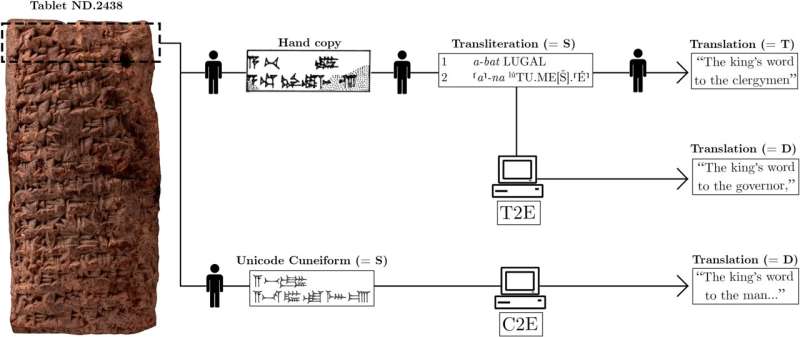Machine translation for cuneiform tablets

An AI model has been developed to automatically translate Akkadian text written in cuneiform into English. Hundreds of thousands of clay tablets from ancient Mesopotamia, written in cuneiform and dating back as far as 3,400 BCE, have been found by archaeologists, far more than could easily be translated by the limited number of experts who can read them.
Shai Gordin and colleagues present a new machine learning model that can automatically translate Akkadian cuneiform into English. Two versions of the model were trained. The research is published in the journal PNAS Nexus.
One version translates the Akkadian from representations of the cuneiform signs in Latin script (transliterations). Another version of the model translates from unicode representations of the cuneiform signs.
The first version, using Latin transliteration, gave more satisfactory results in this study, achieving a score of 37.47 in the Best Bilingual Evaluation Understudy 4 (BLEU4), a test of the level of correspondence between machine and human translation of the same text.
The program is most effective when translating sentences of 118 or fewer characters. In some of the sentences, the program produced “hallucinations”—output that was syntactically correct in English but not accurate to the Akkadian meaning.
But in the majority of cases, the translation would be usable as a first-pass at the text. The authors propose that machine translation can be used as part of a “human-machine collaboration,” in which human scholars correct and refine the models’ output.
More information:
Gai Gutherz et al, Translating Akkadian to English with neural machine translation, PNAS Nexus (2023). DOI: 10.1093/pnasnexus/pgad096
Provided by
PNAS Nexus
Citation:
Machine translation for cuneiform tablets (2023, May 3)
retrieved 3 May 2023
from https://techxplore.com/news/2023-05-machine-cuneiform-tablets.html
This document is subject to copyright. Apart from any fair dealing for the purpose of private study or research, no
part may be reproduced without the written permission. The content is provided for information purposes only.
For all the latest Technology News Click Here
For the latest news and updates, follow us on Google News.
